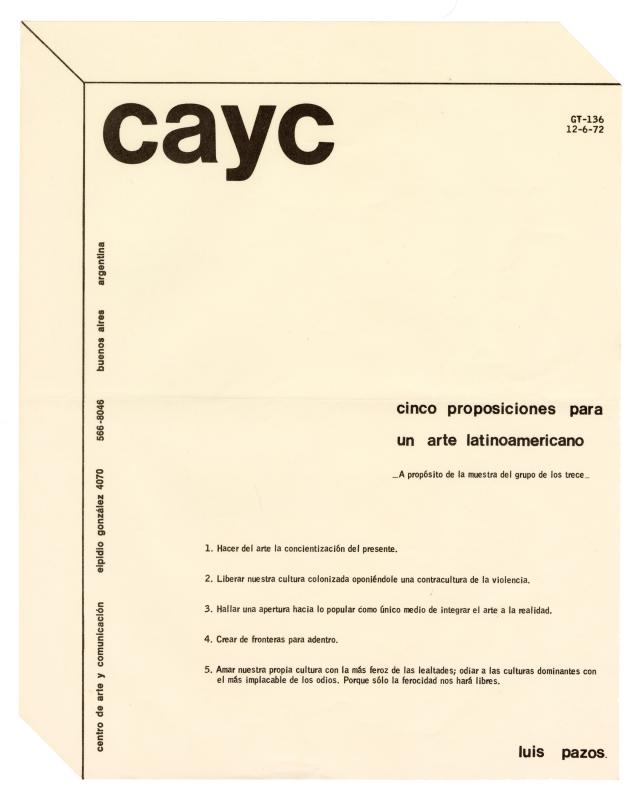Ever since it was founded, the CAYC (Centro de Arte y Comunicación), helmed by the cultural promoter, artist, and businessman Jorge Glusberg, was intended as an interdisciplinary space where an experimental art movement could flourish. The establishment of collaborative networks connecting local and international artists and critics played a key role in this process. The exhibitions shone a light on these exchanges, in which overviews of trends or individual artists introduced the innovations of international contemporary art and made Argentine and Latin American artists better known on the global scene.
This newsletter lists the Argentinean and international artists, and their works, that took part in Hacia un perfil del arte latinoamericano, the exhibition that opened on June 22, 1972, at the CAYC’s premises. This was one of the first times that this title was used, after the exhibition had been presented at the III Bienal Coltejer in Medellín, Colombia (although this title did not appear in the catalogue for that event) and, subsequently, at the Salón de la Independencia in Quito, the capital of Ecuador; both of those events took place in May of that year. This exhibition unquestionably marked a change of direction in the center’s discourse which, in its earliest years, had focused on exploring the link between art and technological development. Nevertheless, art and cybernetics exhibitions were shown internationally in tandem with Hacia un perfil… on several occasions in the following years. When he announced the opening of the exhibition [ GT-133 (doc. no. 14763120)], Glusberg stated that: “There is no Latin American art as such, but the region’s individual countries do share a common problem in terms of their revolutionary situation.” The artist’s role now consisted of highlighting “the conflicts caused by the unjust social relationships that are rampant in Latin American countries.” There was no mistaking the veiled reference to the dictatorial regimes that held power in the region.
The CAYC’s change of direction in mid-1972 coincided with the first presentation of works by the group called the Grupo de los Trece, whose original members included Jacques Bedel, Luis (Fernando) Benedit, Gregorio Dujovny, Carlos Ginzburg, Victor Grippo, Jorge González Mir, Jorge Glusberg, Vicente Marotta, Luis Pazos, Alberto Pellegrino, Alfredo Portillos, Juan Carlos Romero, and Julio Teich. Both Horacio Zabala and Clorindo Testa—who are listed here as “guests”—would, in later years, become key members of the group.
[Para mayor información al respecto, ver GT-125 (doc. no. 1476409) y sobre el perfil GT-136 (doc. no. 1476334)].


